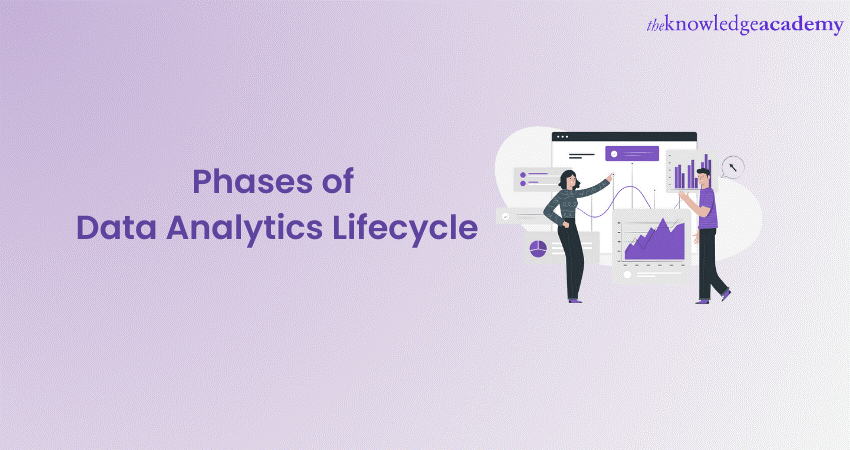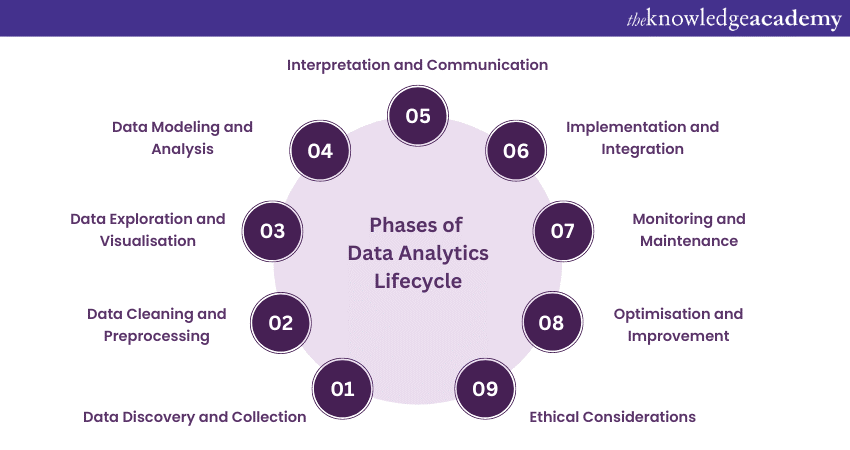We may not have the course you’re looking for. If you enquire or give us a call on 01344203999 and speak to our training experts, we may still be able to help with your training requirements.
Training Outcomes Within Your Budget!
We ensure quality, budget-alignment, and timely delivery by our expert instructors.

Data Analytics Lifecycle explains in detail the several phases data undergoes throughout its period. Hence, an understanding of Data Analytics Lifecycle is very important for professionals working on these projects. The phases are arranged in a manner that each step has its significance and characteristics.
As far as the number of phases in the Data Analytics Lifecycle is concerned, there is no fixed number of phases. Each phase of the Data Analytics Lifecycle has specific objectives and activities that are tailored to the unique requirements of Data Analytics projects. In this blog, you will learn everything about what is Data Analytics Lifecycle in a step-by-step guide, including why it is so important.
Table of Contents
1) Data Discovery and Collection
2) Data Cleaning and Preprocessing
3) Data Exploration and Visualisation
4) Data Modelling and Analysis
5) Interpretation and Communication
6) Implementation and Integration
7) Monitoring and Maintenance
8) Optimisation and Improvement
9) Ethical Considerations
10) Conclusion
1. Data discovery
The first phase of the Data Analytics Lifecycle is the data discovery step. This stage involves identifying potential data sources, both internal and external, that are relevant to the business problem at hand. It is essential to define the scope of the analysis and gather data from various databases, applications, and online repositories. Data can come in different formats, including structured, unstructured, and semi-structured data.
The key to success in this phase is to ensure the data collected is accurate, relevant, and comprehensive. Missing or flawed data can lead to misleading insights and decisions down the line. Rigorous data quality checks and validation procedures are necessary to maintain data integrity.

2. Data preparation
Once the data is collected, it is crucial to clean and preprocess it before analysis. Data preparation involves identifying and rectifying errors, duplications, and inconsistencies in the dataset. This process ensures that the data is of high quality and ready for further analysis.
Data preprocessing tasks may include data transformation, normalisation, and handling missing values. Cleaning and preprocessing are time-consuming but vital steps that significantly impact the accuracy and reliability of the final results. Proper data preprocessing can also help in dealing with noise and irrelevant data, leading to better outcomes.
3. Data exploration
The Data exploration phase aims to gain a deeper understanding of the dataset. It involves generating summary statistics, creating visual representations, and identifying patterns or trends within the data. Data visualisation techniques, such as charts, graphs, and heatmaps, are powerful tools for presenting complex information in a clear and accessible manner.
Through data exploration and visualisation, analysts can identify outliers, correlations, and potential relationships among variables, providing valuable insights that may have gone unnoticed otherwise. Visualising data can make patterns more apparent and facilitate communication of findings with stakeholders.
4. Data Modelling and analysis
Data modelling is a very critical phase of the Data Analytics Lifecycle. In this phase, analysts use various statistical and Machine Learning (ML) techniques to develop models that can predict outcomes, classify data, or identify patterns. The choice of the appropriate model depends on the nature of the business problem and the type of data available.
It is crucial to select the right model and fine-tune its parameters to achieve accurate and reliable results. Analysts may need to iterate and refine the model to ensure it meets the desired performance standards. Model evaluation and validation are critical to assess how well the model generalises to new data.
5. Interpretation and communication
Once the data is analysed and the models are built, it's time to interpret the results and communicate the findings effectively. The insights gained from Data Analytics are only valuable if they can be understood and acted upon by stakeholders.
In this phase, Data Analysts need to present their findings in a clear and concise manner, using language that is accessible to non-technical audiences. Visual aids, such as charts and infographics, can be particularly helpful in conveying complex information. Effective communication ensures that decision-makers grasp the implications of the analysis and can make informed choices.
6. Implementation and integration
The implementation phase involves putting the insights derived from Data Analytics into action. This may include making data-driven decisions, optimising processes, or integrating the findings into existing systems or strategies.
Effective implementation requires collaboration between Data Analysts and decision-makers, ensuring that the recommendations align with the organisation's goals and objectives. Integration of Data Analytics with business operations can lead to improved efficiency and better outcomes.
Planning and implement a big data approach to your organisation with our Big Data Analysis Training!
7. Monitoring and maintenance
Data Analytics is not a one-time process; it requires continuous monitoring and maintenance to remain relevant and effective. New data may become available, and business needs may evolve, necessitating updates to the existing models or analyses.
Regular monitoring helps to identify potential issues or changes in the data, ensuring the accuracy and reliability of the insights over time. Ongoing monitoring allows organisations to adapt to changing market conditions and stay ahead of the competition.
8. Optimisation and improvement
The optimisation and improvement phase of the Data Analytics Lifecycle is a critical step in enhancing the overall effectiveness and efficiency of the Data Analytics process. In this phase, Data Analysts dive into the insights and outcomes generated during the data modelling and analysis stage and identify areas for refinement and enhancement. By fine-tuning the existing models and methodologies, analysts can uncover hidden patterns, optimise predictive accuracy, and gain more valuable insights from the data.
This phase involves a deep dive into the performance metrics of the developed models, such as accuracy, precision, recall, and F1-score, among others. Data Analysts assess how well the models are predicting outcomes and whether any discrepancies or errors need to be addressed. Based on this evaluation, they can apply advanced techniques, such as hyperparameter tuning or feature engineering, to improve the model's performance.
Moreover, analysts also consider the feedback received from stakeholders and decision-makers who have implemented the insights from the data analytics. This feedback can provide valuable information on the real-world impact of data-driven decisions and identify any areas where the analytics process might need to be adjusted.
As technology and business environments are constantly evolving, Data Analysts must stay up-to-date with the latest advancements in the field. Continuous learning and exploration of new tools and methodologies are essential in this phase to ensure that the Data Analytics process remains cutting-edge and effective.
Additionally, the "Optimisation and Improvement" phase is an opportunity to explore alternative data sources or include additional data features that were not initially considered. This broader scope can potentially reveal new insights and lead to more comprehensive analyses.
Data Analysts should also consider the scalability and robustness of their Data Analytics solutions during this phase. As businesses grow and data volumes increase, the analytics process must be capable of handling larger datasets without compromising accuracy or speed. Optimisation efforts may involve fine-tuning the infrastructure and computational resources to accommodate future growth.
Collaboration among Data Analysts, domain experts, and decision-makers is crucial in this phase. Open communication and feedback loops facilitate the identification of improvement opportunities and ensure that the Data Analytics process remains aligned with business objectives.

9. Ethical considerations
Throughout the Data Analytics Lifecycle, it is essential to address ethical considerations surrounding data privacy, security, and bias. As Data Analysts work with sensitive information, they must adhere to ethical guidelines and ensure the responsible use of data.
Being transparent about data collection and analysis methods and actively mitigating biases helps build trust with stakeholders and the broader audience. Respecting privacy and confidentiality is vital to protect individuals and maintain the integrity of the Data Analytics process.
Conclusion
The Data Analytics Lifecycle is a comprehensive process that takes raw data and transforms it into valuable insights that drive business decisions. From data collection and cleaning to interpretation, implementation, and continuous evaluation, each stage plays a vital role in the success of Data Analytics initiatives. Embracing this lifecycle and leveraging the power of data can empower businesses to stay ahead and make data-driven decisions that lead to long-term success.
Gain in-depth knowledge of Data Analytics with our Data Analytics With R Course!
Frequently Asked Questions
Upcoming Data, Analytics & AI Resources Batches & Dates
Date
 Hadoop Big Data Certification
Hadoop Big Data Certification
Thu 12th Sep 2024
Thu 12th Dec 2024







 Top Rated Course
Top Rated Course


 If you wish to make any changes to your course, please
If you wish to make any changes to your course, please


